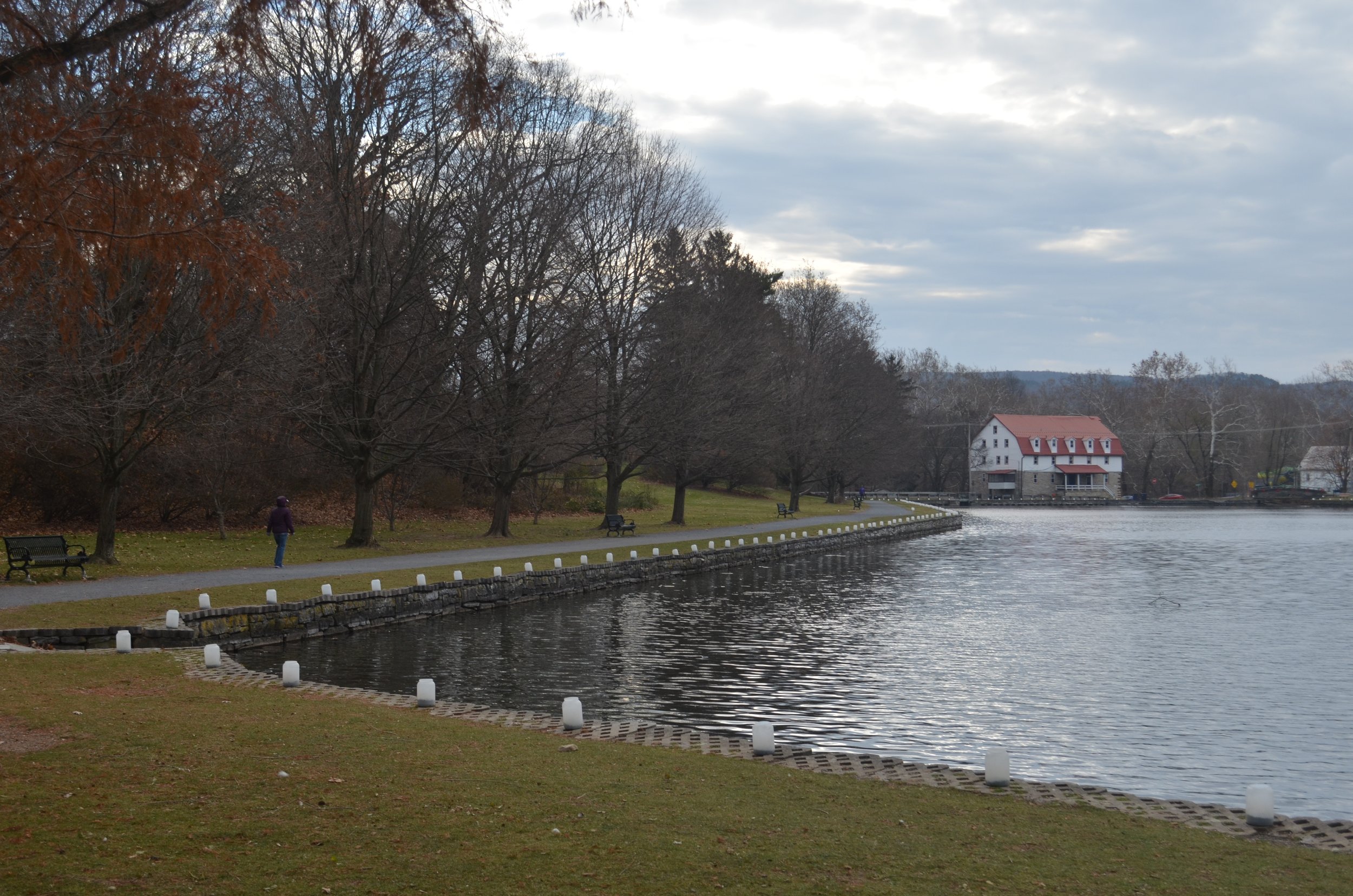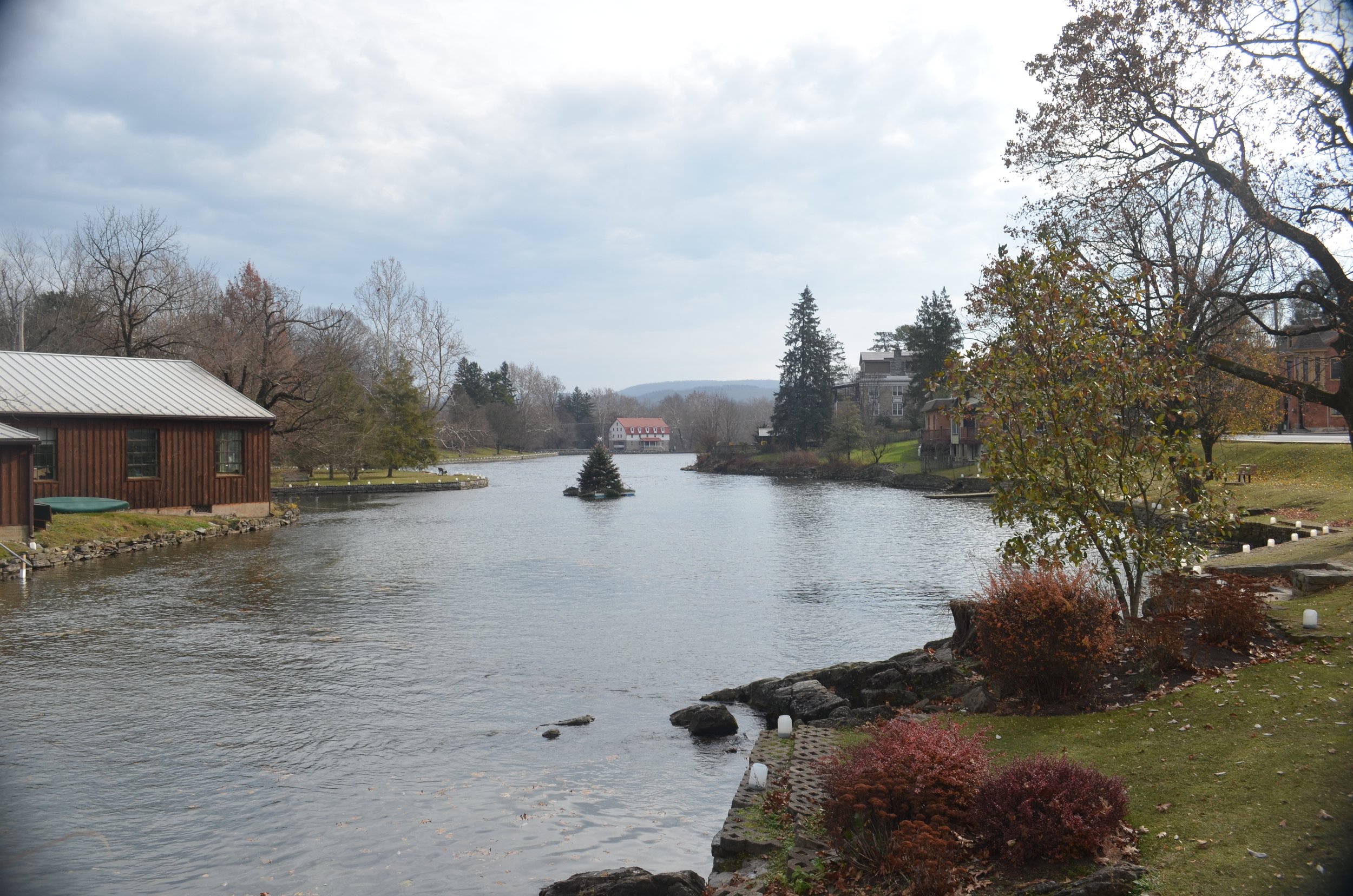Traveling to History: Fifteen
A WALK THROUGH THREE CENTURIES OF HISTORY IN TINY BOILING SPRINGS, PA.
By James F. Lee
Children’s Lake in Boiling Springs looking south. The 1780 grist mill in the distance is now an apartment house. (Photo by James F. Lee)
If you drive by Boiling Springs, Pennsylvania on PA Rt. 174 (First Street), the first thing that attracts your attention is the seven-acre Children’s Lake in the heart of the town. On the eastern side of the lake, the Appalachian Trail skirts the tree-lined shore; on the other side impressive homes along Front Street stand out on the higher ground.
The village is unique in its way, according to Richard Tritt, Photo Curator of the Cumberland Valley Historical Society.
“It has vestiges of its origins as an 18th-century industry and maintains … 19th century homes in a variety of architectural styles,” Tritt said in an email.
In fact, a short walk around the lake compresses three centuries of history.
The Carlisle Iron Works charcoal furnace stack is all that remains of the iron works. This furnace stack was built about 1760. (Photo by James F. Lee)
An Industrial Past
The lake and mill run were formed in the 1730s to power a grist mill on the south shore. By 1760, the Cumberland Iron Works was formed near the mill run, utilizing ore mined on nearby South Mountain, and charcoal produced from the ample timber in the area. Pre-Revolution mills might export pig iron to Britain or produce manufactured items, such as stoves and kettles, for local markets. During the Revolutionary War, the works at Boiling Springs produced munitions for the Patriot cause.
All that you will see today of this industrial complex is the four-sided charcoal furnace stack that stands about 30 feet high, near the mill run and the Yellow Breeches River. The iron works closed around 1895.
Michael Ege (egg-E) built this Georgian-style mansion around 1780. Known today as the Ege-Bucher mansion it has 16 rooms and is privately owned. (Photo by James F. Lee)
Not far from the iron furnace, on a hill overlooking the lake, you can’t miss the Ege-Bucher Mansion, a two and a half story white Georgian-style structure built in 1795 with an impressive portico added in the 20th century. Michael Ege (pronounced egg-E) was the ironmaster of the Carlisle Works. His lovely house stands atop terraced gardens that are being renovated to their earlier charm. Today, the building is a private residence.
The large building with a gambrel roof and limestone foundation standing at the southern end of the lake was a grist mill built around 1784 by Michael Ege. The building today houses apartments.
Another vestige of the Ege family is the Stone Arch Bridge over the Yellow Breeches built in 1854 to provide access to the Ege’s Carlisle Iron Works.
This stone triple-arched bridge over Yellow Breeches Creek (1854) brought materials to and from the Carlisle Iron Works in Boiling Springs. (Photo by James F. Lee)
Boiling Spring’s Connection to the Underground Railroad.
In 1845, Daniel Kaufman, owner of much of the surrounding land, laid out the village on the west side of the lake. An abolitionist actively involved in the Underground Railroad, Kaufman sheltered escaped enslaved people in his barn as they made their way North to freedom. Ironically, enslaved people lived in the village working at the Ege estate and at the ironworks.
In 1847, Kaufman faced several lawsuits for aiding escaped enslaved people. Despite being defended by such luminaries as Thaddeus Stevens, he eventually was found guilty and made to pay damages and costs.
An interesting historical footnote illustrates the divide faced by the country over the question of slavery. Despite Daniel Kaufman’s abolitionist beliefs, his brother David was ardently pro-slavery, and moved to Texas where he became the first representative from Texas to the U.S. Congress. Kaufman County Texas is named after him.
Today, the Children’s Lake is home to ducks and geese. (Photo by James F. Lee)
Village Architecture
Today, the village runs three blocks from the lake’s western shore and includes some outstanding examples of American architecture. Kaufman’s ante-bellum house and barn no longer exist, but the federal-style brick house he built in 1880 still stands on Front Street. The paired brackets underneath the eaves, decorative moldings above the windows, and the single-story front porch are Italianate touches popular in the country at that time. Outside, a marker placed by the Pennsylvania Historical and Museum Commission tells Kaufman’s story.
Other significant houses on Front Street include The Dr. Houch House at the corner of Third Street, a notable Queen Anne style wooden structure, built circa 1870. Queen Anne style was new to the United States at the time this house was built, and this one with its high tower at the front right corner, wide porch, and irregular roof line and steeply pitched gables is great example. Next door, The Ahl House, built around the same time as Dr. Houch’s, is notable by its massive mansard roof typical of the Second Empire style. If you look closely, you can see the molded cornices and decorative brackets, also typical of the style, as well as the paired front doors with glass on the top.
The only known photo of Daniel Kaufman, taken shortly before his death in 1902. (Courtesy Cumberland County (Pa) Historical Society)
As you walk up Front Street towards First (Pa Rt 174), the streetscape reflects earlier federal style, symmetrical brick houses with flat exteriors that come right to the sidewalk. Many of these houses were built between 1845 and 1860. Across the street is a limestone clocktower built in 1957.
Strolling these streets you come upon surprises, such as the Gothic Villa on Third Street with its four-story tower and steeply pitched gables. The sheer size of the building is impressive. Or the Pumpkin House, also on Third, whose name derives from its striking pumpkin color.
One of the earliest structures built in the village is the Boiling Springs Tavern, located on Route 174. A federal style limestone structure built circa 1832 as a hotel, it still operates as a restaurant and bar. One of the springs feeding the lake is at the rear of the tavern.
Daniel Kaufman’s house in Boiling Springs, built circa 1880. Kaufman’s house has a commanding view of the lake. (Photo by James F. Lee)
Natural Attractions
By the late 1800s, Boiling Springs’ natural beauty attracted visitors enjoying the lake and Yellow Breeches River, as well as the water from the springs. A park was built on the north side of the lake, including a carousel, dance hall, picnic sites, and shops. Many visitors came to the lake on the trolley that ran from Carlisle until the park closed in 1930. Two buildings remaining from that time include the Appalachian Trail Commission office, which was then a restaurant, and Yellow Breeches Outfitters fly shop, the former dance hall.
Today, natural attractions still offer plenty of options for visitors.You can boat on the lake, now called Children’s Lake, enjoy excellent fly fishing on the nearby Yellow Breeches, and hike several trails, including the Appalachian Trail.
Tiny Boiling Springs boasts notable examples of American architecture. Here on Third Street are examples from right to left of Second Empire, Queen Anne, and Federal styles. (Photo by James F. Lee)
The limestone clock tower at the north end of Children’s Lake was dedicated in 1957 honoring fallen veterans of foreign wars. (Photo by James F. Lee)
Children’s Lake from the north end. The floating Christmas tree in the center is there for the holidays. (Photo by James F. Lee)










